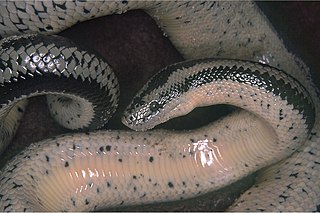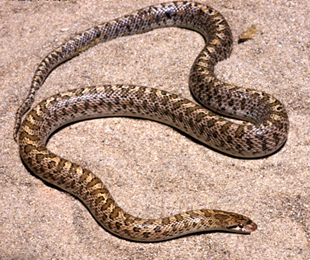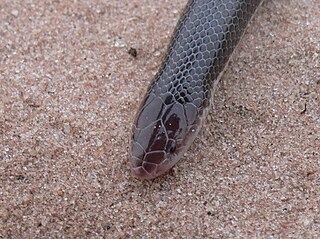
The desert rosy boa is a species of snake in the family Boidae. The desert rosy boa is native to the American Southwest and Baja California and Sonora in Mexico. The desert rosy boa is one of four species in the boa family native to the continental United States, the other three being the coastal rosy boa and the two species of rubber boas (Charina).

Arizona elegans is a species of medium-sized colubrid snake commonly referred to as the glossy snake or the faded snake, which is endemic to the southwestern United States and Mexico. It has several subspecies. Some have recommended that A. elegans occidentalis be granted full species status.

Crotalus basiliscus, known as the Mexican west coast rattlesnake, Mexican green rattler, and also by other names, is a species of pit viper in the family Viperidae. The species is endemic to western Mexico. Like all other pit vipers, it is venomous. The specific name, basiliscus, is derived from the Greek word for king, βασιλισκος, and alludes to this snake's large size and potent venom. No subspecies are currently recognized.

Crotalus helleri, known as the Southern Pacific rattlesnake, black diamond rattlesnake, and by other names, is a pit viper subspecies found in southwestern California and south into Baja California, Mexico, that is known for its regional variety of dangerous venom types.

The western diamondback rattlesnake or Texas diamond-back is a rattlesnake species and member of the viper family, found in the southwestern United States and Mexico. Like all other rattlesnakes and all other vipers, it is venomous. It is likely responsible for the majority of snakebite fatalities in northern Mexico and the greatest number of snakebites in the U.S. No subspecies are currently recognized.

Crotalus viridis nuntius is a venomous pit viper subspecies native primarily to the desert plateau of the northeastern portion of the American state of Arizona, but also ranges into northwestern New Mexico. Named for the Native American Hopi tribe, which inhabits the region, its range overlaps that of the nominate subspecies and some interbreeding is believed to occur. The taxonomy of the C. viridis group is a matter of debate, many considering the various subspecies to be nothing more than locality variations.

Atractaspis bibronii is a species of venomous snake in the family Atractaspididae. The species is endemic to Africa. There are no subspecies that are recognized as being valid.

Arizona elegans arenicola, commonly known as the Texas glossy snake, is a subspecies of nonvenomous colubrid snake endemic to North America.

Sistrurus tergeminus edwardsii, also known as the desert massasauga, is a subspecies of venomous pit viper in the family Viperidae. The subspecies is endemic to the Southwestern United States and northern Mexico. In places, its range overlaps that of S. t. tergeminus, and intergrading of the two subspecies is known.

Crotalus oreganus abyssus is a venomous pit viper subspecies found only in the U.S. states of Arizona and Utah.

Crotalus oreganus, commonly known as the (northern) Pacific rattlesnake, is a venomous pit viper species found in western North America from the Baja California Peninsula to the southern interior of British Columbia.

Crotalus atrox tortugensis is a venomous pit viper subspecies found only on Tortuga Island in the Gulf of California.

The Great Basin rattlesnake is a venomous pit viper species found in the Great Basin region of the United States.

Crotalus cerberus is a venomous pit viper species found in the southwestern United States. It is known as the Arizona black rattlesnake, black rattlesnake, and several other common names.

The California night snake is a subspecies of small colubrid snake native to California.

The Pacific gopher snake is a subspecies of large non-venomous colubrid snake native to the western coast of North America.
Wyoming is home to 12 amphibian species and 22 species of reptiles.
















